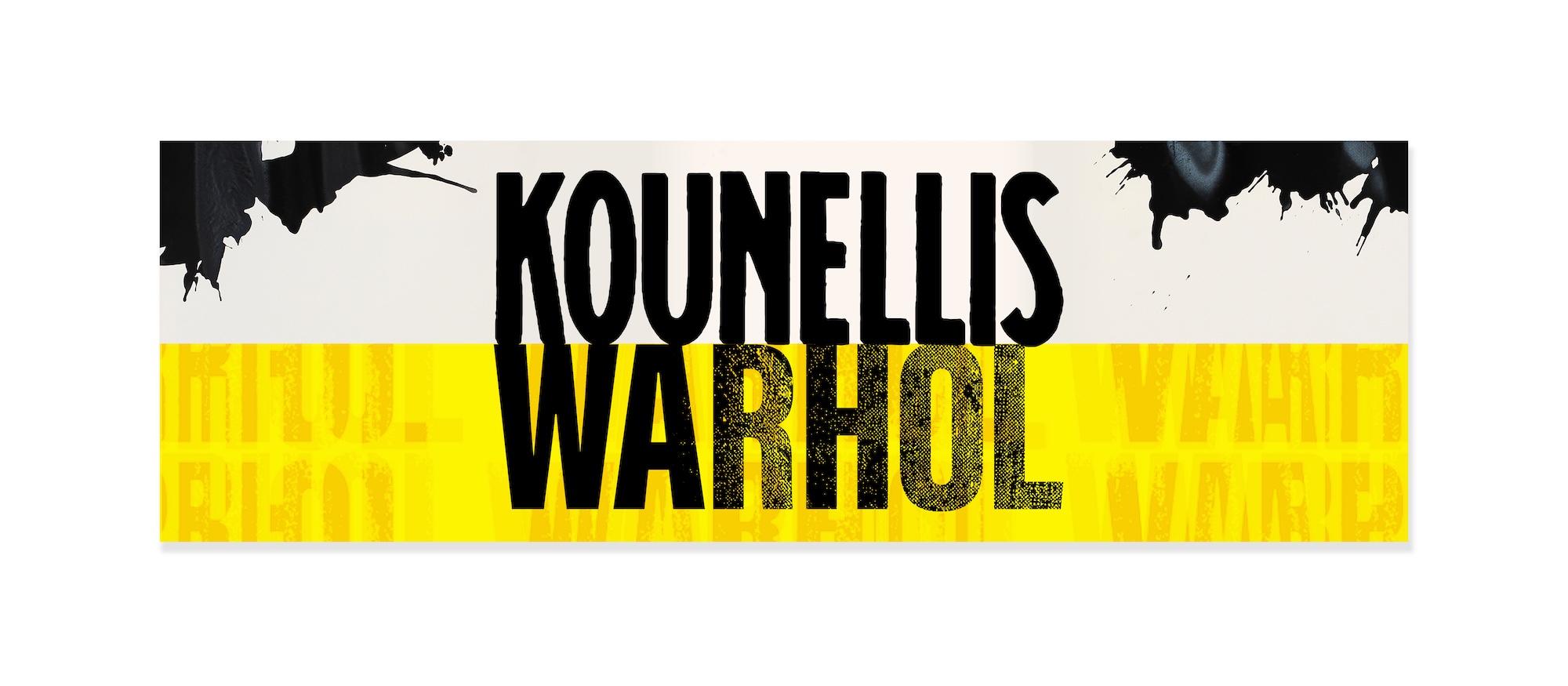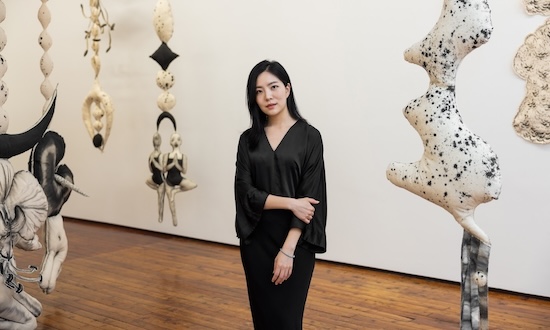
KOUNELLIS | WARHOL
Staging the human tragedy: Jannis Kounellis’s Classicism and Andy Warhol’s Pop 26 November, 2025 - 29 May, 2026
KOUNELLIS | WARHOL
Staging the human tragedy: Jannis Kounellis’s Classicism and Andy Warhol’s Pop 26 November, 2025 - 29 May, 2026

Text
Galleria Fumagalli presents the exhibition Kounellis | Warhol. Staging the human tragedy: Jannis Kounellis’s Classicism and Andy Warhol’s Pop.
Far from any attempt to reduce the two masters of contemporary art to the same matrix and rejecting any comparison that might flatten their identity, the exhibition manifests as an opportunity for critical reflection on Jannis Kounellis and Andy Warhol, with their ideological and aesthetic differences, but also with their shared cultural backgrounds and fascination with the power and mystery of spirituality.
The exhibition project at Galleria Fumagalli develops at Museo San Fedele, Milano which, opening on 12 December, will present an unprecedented dialogue between Jannis Kounellis’s permanent work in the crypt and a work by Andy Warhol on loan for the occasion.
The exhibition will be followed by a comprehensive publication featuring critical contributions and personal memoirs by prominent authors such as Andrea Dall’Asta SJ, Demetrio Paparoni, Gianni Mercurio, Gerard Malanga, Lóránd Hegyi, Luca Massimo Barbero, Franco Fanelli, Annamaria Maggi, Maria Vittoria Baravelli, Sandro Barbagallo, and Massimo Recalcati, among others.
The volume features significant auctorial photographs, and will be presented during the exhibition.
Jannis Kounellis (Piraeus, Greece, 1936 – Rome, Italy, 2017) and Andy Warhol (Pittsburgh, Pennsylvania, 1928 – New York, 1987) radically influenced their time, leaving a profound mark on the history of art. At first glance, they seem to embody two irreconcilable archetypes: the alpha and omega of two artistic visions of art and reality that have confronted and, at times, clashed. Their paths developed in parallel, yet in almost diverse universes: Kounellis immersed in the shadow and in the weight of matter, Warhol in the fluorescent glare of the image surface.
Yet today, long after that historical period – with ideologies dissolved, the Berlin Wall fallen, and perhaps on the verge of its reconstruction – it seems urgent and fruitful to rekindle a dialogue between these two masters. Doing so does not only mean comparing their differences, but above all exploring the common roots of that great energy that animated an unrepeatable period in contemporary art, as well as probing the common ground that gave life to that extraordinary season.
Both artists are an expression of the Western world and considered themselves as children of two cities that we can call “caput mundi”: Rome in the ancient times and Christianity; New York as the capital of the global imagination in the post-war period and the engine of capitalism. But both artists maintain a profound connection to their Eastern roots and the spiritual traditions of their homelands: Orthodox and Mediterranean Greece for Kounellis, Catholic Slovakia with its Byzantine influences that permeates Warhol’s memory.
Anyone who approaches their work today encounters a word that is as recurrent as insidious: icon. A word that risks becoming a semantic trap, emptied of meaning by excessive use. Everything is “iconic”: every face, every object, every image. But for Kounellis and Warhol, the icon is not a simple object of media worship; it maintains, even in explicitly profane contexts, a tension towards absolute truth.
In Kounellis, this tension manifests through the objects of daily work, humble materials, primary elements: iron, coal, jute bags, coats, flames. His is a secular, even materialistic, liturgy – a tragic rite in which the world’s pain finds expression in matter itself. In Warhol the sacred hides behind the symbols of consumption and celebrity: Campbell’s soup cans, Brillo boxes, Marilyn’s or Jackie Kennedy’s portrays, women who conceal their pain in beauty. But behind that glossy surface lies an intimate spirituality, a sense of tragedy that transforms those images into modern icons.
While Kounellis is ideological, tied to a political vision of the world and history, Warhol is ambiguous, concealed, but no less profound. Both, in their own way, addressed the masses, the people, the marginalized. There is nothing triumphant in their works: there is “the poor” and “the people”, a humanistic revolution, which art redeems by elevating it to a symbol.
The beauty that emerges from their works is tragic, but never desperate. It is the beauty of what remains, of what survives the disenchantment of history and consumption. And perhaps it is in this common ground – the tragedy of everyday life, the universality of the material, and the rigorous ethics of the artist – that the key to a possible dialogue between the two artists can be found.
Despite everything.
Text
Galleria Fumagalli presents the exhibition Kounellis | Warhol. Staging the human tragedy: Jannis Kounellis’s Classicism and Andy Warhol’s Pop.
Far from any attempt to reduce the two masters of contemporary art to the same matrix and rejecting any comparison that might flatten their identity, the exhibition manifests as an opportunity for critical reflection on Jannis Kounellis and Andy Warhol, with their ideological and aesthetic differences, but also with their shared cultural backgrounds and fascination with the power and mystery of spirituality.
The exhibition project at Galleria Fumagalli develops at Museo San Fedele, Milano which, opening on 12 December, will present an unprecedented dialogue between Jannis Kounellis’s permanent work in the crypt and a work by Andy Warhol on loan for the occasion.
The exhibition will be followed by a comprehensive publication featuring critical contributions and personal memoirs by prominent authors such as Andrea Dall’Asta SJ, Demetrio Paparoni, Gianni Mercurio, Gerard Malanga, Lóránd Hegyi, Luca Massimo Barbero, Franco Fanelli, Annamaria Maggi, Maria Vittoria Baravelli, Sandro Barbagallo, and Massimo Recalcati, among others.
The volume features significant auctorial photographs, and will be presented during the exhibition.
Jannis Kounellis (Piraeus, Greece, 1936 – Rome, Italy, 2017) and Andy Warhol (Pittsburgh, Pennsylvania, 1928 – New York, 1987) radically influenced their time, leaving a profound mark on the history of art. At first glance, they seem to embody two irreconcilable archetypes: the alpha and omega of two artistic visions of art and reality that have confronted and, at times, clashed. Their paths developed in parallel, yet in almost diverse universes: Kounellis immersed in the shadow and in the weight of matter, Warhol in the fluorescent glare of the image surface.
Yet today, long after that historical period – with ideologies dissolved, the Berlin Wall fallen, and perhaps on the verge of its reconstruction – it seems urgent and fruitful to rekindle a dialogue between these two masters. Doing so does not only mean comparing their differences, but above all exploring the common roots of that great energy that animated an unrepeatable period in contemporary art, as well as probing the common ground that gave life to that extraordinary season.
Both artists are an expression of the Western world and considered themselves as children of two cities that we can call “caput mundi”: Rome in the ancient times and Christianity; New York as the capital of the global imagination in the post-war period and the engine of capitalism. But both artists maintain a profound connection to their Eastern roots and the spiritual traditions of their homelands: Orthodox and Mediterranean Greece for Kounellis, Catholic Slovakia with its Byzantine influences that permeates Warhol’s memory.
Anyone who approaches their work today encounters a word that is as recurrent as insidious: icon. A word that risks becoming a semantic trap, emptied of meaning by excessive use. Everything is “iconic”: every face, every object, every image. But for Kounellis and Warhol, the icon is not a simple object of media worship; it maintains, even in explicitly profane contexts, a tension towards absolute truth.
In Kounellis, this tension manifests through the objects of daily work, humble materials, primary elements: iron, coal, jute bags, coats, flames. His is a secular, even materialistic, liturgy – a tragic rite in which the world’s pain finds expression in matter itself. In Warhol the sacred hides behind the symbols of consumption and celebrity: Campbell’s soup cans, Brillo boxes, Marilyn’s or Jackie Kennedy’s portrays, women who conceal their pain in beauty. But behind that glossy surface lies an intimate spirituality, a sense of tragedy that transforms those images into modern icons.
While Kounellis is ideological, tied to a political vision of the world and history, Warhol is ambiguous, concealed, but no less profound. Both, in their own way, addressed the masses, the people, the marginalized. There is nothing triumphant in their works: there is “the poor” and “the people”, a humanistic revolution, which art redeems by elevating it to a symbol.
The beauty that emerges from their works is tragic, but never desperate. It is the beauty of what remains, of what survives the disenchantment of history and consumption. And perhaps it is in this common ground – the tragedy of everyday life, the universality of the material, and the rigorous ethics of the artist – that the key to a possible dialogue between the two artists can be found.
Despite everything.



